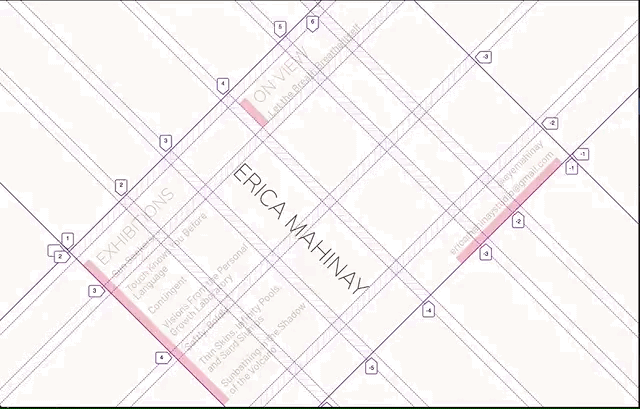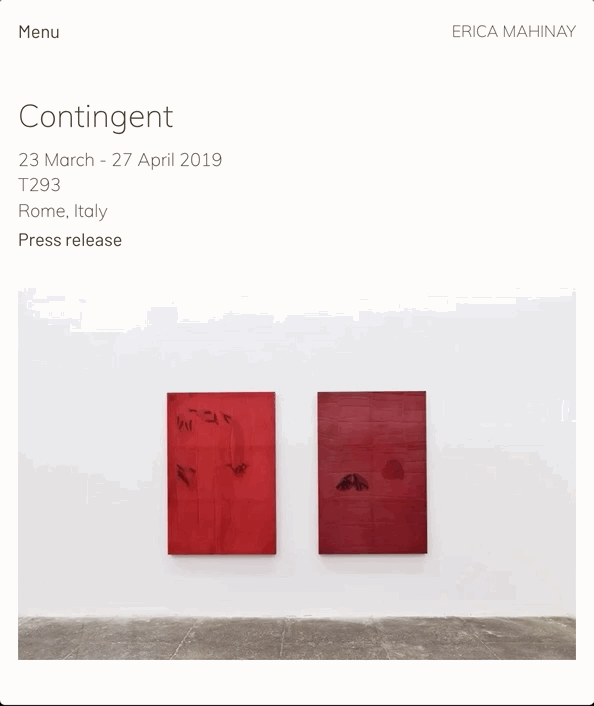Erica Mahinay
September 22, 2019
With so many content management options these days, it's hard to know which platform to select. Gatsby's content mesh architecture and plugin ecosystem makes it seamless and enjoyable to work with a host of systems. One of the most popular is Contentful. With a nice UI for uploading and editing content, a great source plugin to Gatsby, and a generous free entry package, Contenful fast became one of my favorite tools for content management. Alongside unique grid-based responsive designs and spring-based animations, the result is a sleek, modern-day portfolio for the LA-based artist, Erica Mahinay.
CSS Grid Landing Page
Jen Simmons has one of my favorite personal sites out there. The gridded landing page that responsively generates new layouts is a true gem and I wanted to incorporate a similar feature on Erica's site.
Large screens
A rotated grid paired with a vertical text header in the grid provides a striking container to house the landing page elements.

The JSX behind the grid is a container for the following four grid-items:
- Exhibitions currently on view
- Past exhibitions
- Name
- Contact information
src/pages/index.js
const IndexPage = () => {
// ... fetch Contentful data
return (
<div className="grid">
<h1 className="name">Erica Mahinay</h1>
<div className="exhibition-list">
//... list of past exhibitions
</div>
<div className="onview-list">
//... list of exhibitions on view
</div>
<div className="contact">
//... contact information
</div>
</div>
)
}And the corresponding CSS to achieve the rotated grid:
.grid {
width: 66vw;
margin: auto;
transform: rotate(-45deg);
display: grid;
grid-template-columns: 1fr 0.75fr 1fr 1fr 0.5fr 1fr;
grid-template-rows: auto 1fr auto auto 0.5fr;
}Each of the direct children to .grid become grid-items and are positioned by axes indices using grid-column and grid-row.
The name header is placed near the middle of the 6-column grid with its text displayed vertically:
.name {
grid-column: 3 / 4;
grid-row: 3 / 5;
writing-mode: vertical-lr;
justify-self: center;
}The past exhibition list is flush with the leading two columns of the grid and claims all rows in those columns.
.exhibition-list {
grid-column: 1 / 3;
grid-row: 1 / 5;
align-self: center;
}The grid's top right corner is reserved for exhibitions currently on view:
.onview-list {
grid-column: 4 / 7;
grid-row: 2;
align-self: end;
}Finally, contact information is tucked in the lower right of the grid:
.contact {
grid-column: 4 / 7;
grid-row: 5;
align-self: end;
}Small screens
For screens below 700px, the grid unrotates and morphs dimensions from [6 X 5] to [3 X 2] to more naturally align with vertical mobile viewports.

Then, each grid-item receives a new placement in the updated grid. The name and contact information are pinned to the right column with the exhibitions to the left column.
.name {
grid-column: 2;
grid-row: 1 / 3;
writing-mode: vertical-lr;
justify-self: end;
text-transform: uppercase;
}
.contact {
grid-column: 1 / 3;
grid-row: 3;
justify-self: end;
text-align: right;
margin-right: 1rem;
}
.onview-list {
grid-column: 1;
grid-row: 1;
align-self: end;
}
.exhibition-list {
grid-column: 1;
grid-row: 2;
}Spring-based animations
I've been diving into react-spring during recent projects for creating realistic animations based on physics and the motion of springs. A custom hook useSpring is provided by the package to quickly configure animated values, where the animation can be controlled by state in the component. This technique is employed to toggle visibility of the mobile nav when the menu button is clicked.
The useSpring hook and the animated tag wrapper are first imported from react-spring. We then setup a slice of state called isMenuOpen, which is toggled by the corresponding setter function setIsMenuOpen, and initially set to false. The animation props are then created using useSpring, which are distributed among an HTML element via the style prop.
import React, { useState } from 'react;
import { useSpring, animated } from 'react-spring';
const MobileNav = () => {
// Track status of menu open/close for spring animation
const [isMenuOpen, setIsMenuOpen] = useState(false);
// Setup the zoom-in animation
const animation = useSpring({
transform: isMenuOpen
? `translate3d(0,0,0) scale(1)`
: `translate3d(-100%,0,0) scale(0.6)`,
})
return (
<div>
<nav style={animation}>
// ...Nav items
</nav>
<button onClick={() => setIsMenuOpen(!isMenuOpen)}>
</div>
);
}When isMenuOpen turns true, the nav element translates horizontally and scales up into the full viewport.

Contentful CMS
Configuring Contentful for Gatsby
Gatsby sites can seamlessly work with Contenful through its source plugin. After installing it:
npm i gatsby-source-contentful,
it can be configured in the gatsby-config.js file.
require('dotenv').config()
module.exports = {
plugins: [
{
resolve: `gatsby-source-contentful`,
options: {
spaceId: process.env.CONTENTFUL_SPACE_ID,
accessToken: process.env.CONTENTFUL_ACCESS_TOKEN,
downloadLocal: true,
},
}
]
}CONTENTFUL_SPACE_ID and CONTENTFUL_ACCESS_TOKEN values are provided by Contentful after you initialize a new space on its platform. I also included the downloadLocal property so that images would be locally available and sourced into Gatsby images within the site's image detail modal.
Fetching Contentful Data
6 content models are built for the site:
- Blog Post
- CV
- Exhibition
- Image
- Video
- Press
Each of them structures how user-input is collected and validated. Contentful's UI is nice to engage with and allows for highly customized formatting. Each model is made available as a node in Gatsby's GraphQL interface.
Static Queries
Gatsby's useStaticQuery hook is used on GraphQL queries that do not require input variables, such as grabbing all of the press articles to display on the press page.
src/pages/press
import React from 'react'
import { graphql, useStaticQuery } from 'gatsby'
const Press = () = {
const data = useStaticQuery(graphql`
{
allContentfulPress(sort: { fields: order, order: DESC }) {
nodes {
id
date
title
attachment {
file {
url
}
}
link
}
}
}
`)
const pressItems = data.allContentfulPress.nodes
return (
// ... render press items
)
}Dynamic queries
Exhibition pages are dynamically created in gatsby-node.js by sourcing all exhibition entires in Contentful. The page component is passed an exhibitionTitle value in the page's context. This string is then used to source all the images (stored in the Image model) associated with that exhibition.
src/templates/exhibition-template.js
import React from "react"
import { graphql } from "gatsby"
import Img from "gatsby-image"
export const query = graphql`
query($exhibitionTitle: String!) {
allContentfulImage(
filter: { exhibition: { eq: $exhibitionTitle } }
sort: { fields: order, order: ASC }
) {
nodes {
dimensions
id
title
year
imageFile {
fluid(maxWidth: 600) {
...GatsbyContentfulFluid_withWebp
}
}
materials
}
}
}
`
return (
// ... exhibition information and images
)Contentful makes available an imageFile property that syncs with Gatby's image component for sleek, blurred-up image rendering. When a query variable is exported from a Gatsby page, it makes available a data prop to that component containing the GraphQL query result. For instance, to render Gatsby Images beneath the query noted above, it would take the form:
const images = props.data.allContentfulImage.nodes
const renderImages = images.map(image => (
<Img key={image.id} fluid={image.imageFile.fluid} />
)
return (
// ...exhibition information
<div>{renderImages()}</div>
)Overall, the integration of Contenful data with Gatsby's GraphQL interface is a winning combination for speed, security, and developer happiness 😄.